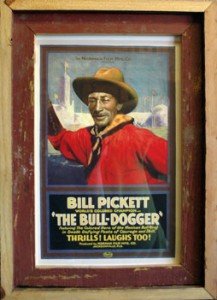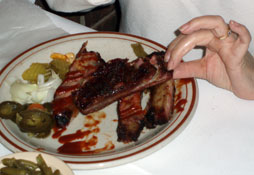By André Green/se news editor

The stories of the Old West are littered with tales of heroism, debauchery, frontier expansion and Indian wars.
Wild Bill Hickok, Wyatt Earp and Bat Masterson are celebrated heroes and legends, whose lives and exploits are deeply ingrained in American history and folklore.
But forgotten in the mosaic of the Old West are the contributions of the men and women of color, whose dedication, bravery and honor paved the way for many to follow.
Jim and Gloria Austin recognized this void in history and did something about it.
The Austins founded the National Cowboys of Color Museum and Hall of Fame after teaming up with Cleo Hearn, Cowboy of Color rodeo producer.
The museum is a quaint-looking, red-bricked former Alzheimer’s center at 3400 Mount Vernon Ave. in East Fort Worth. All of its 6,000 square feet have been methodically utilized, showcasing relics from legends and heroes that time and history have, for the most part, forgotten.
These honored people from different cultures and races all contributed to the history of the Old West.
Rich Robinson, museum coordinator, said the museum’s title is sometimes misunderstood.
“ When we talk about cowboys of color, we don’t just mean [blacks],” he said. “We are talking about Native Americans, Hispanics, Buffalo Soldiers—they all made contributions to our western history.”
At the museum, those forgotten cowboys are highlighted.

Each room in the museum highlights the significant role cowboys, cowgirls and everyday people, ranging from the Old West to today, have played in history.
“ One-third of the frontier was settled by cowboys of color. We want people to remember their stories of heroism and conviction,” he said.
Hall of Fame
The museum’s Hall of Fame highlights the accomplishments of the 26 men and women of color who have made an impact and left an indelible mark in history.
The induction ceremony takes place every year during the Cowboys of Color Rodeo.
Notable inductees include former Pittsburgh Steeler Mel Blount (’05); Country music legend Charlie Pride (’06); Charlie Sampson, the first black world bull riding champion (’03); “The Bronze Buckaroo” Herb Jeffries (’03), and the incomparable Bill Pickett, the father of bull dogging (’03).
This year’s induction ceremony will be Sept. 1 in Will Rogers Coliseum.
The proceeds from the rodeo go toward the operation of the museum and the Renaissance Cultural Center scholarship fund.
Native Americans
The Native American room features the artwork of Canadian painter Mort Graham.
Graham’s fascination with the Plains Indians led him to create a series of images, eventually lost. But an individual found them in an attic and donated them to the museum.
The images of Sitting Bull, Quanah Parker, Crazy Horse and other notable Native Americans adorn the walls of the room.
Hispanics
The depictions of the Hispanic cowboys, or vaqueros, in western films are totally inaccurate, Robinson said.
“ The vaqueros believed gunfights were cowardly,” he said. “They were very brave men and preferred to outsmart you or fight hand to hand with a knife.”
Robinson said lariat making, roping and riding skills that cowboys use today can be attributed to the vaqueros.
The modern rodeo can also be attributed to the vaqueros, Robinson said.
After long cattle drives, the vaqueros would test one another’s bravery by releasing a bull into a field. The vaquero would then ride alongside the bull and grab its tail.
The rider would then swing around the bull, tail in hand, in an attempt to cause the bull to flip over its own tail.
“ The key,” he said, “is not to get pulled off. If the bull makes a sudden turn or the horse makes a full stop, you are in trouble.”
Buffalo Soldiers
At the end of the Civil War, the government needed protection for settlers moving west. A little more than 100 miles from Austin, the frontier began, and renegades and outlaws were plentiful throughout the countryside.
Protection for settlers came in the form of some unlikely heroes who set the standard in the plains.
The buffalo soldiers were made up of black Union soldiers and freed slaves. They were charged with the protection and law enforcement in the frontier.
What was started as an experiment quickly became one of the most successful units in military history.
The unit comprised two units of cavalry, the 9th and 10th, and two infantry units, the 24th and 25th.
It is believed Native Americans respectfully labeled the soldiers “buffalo soldiers” because of their bravery, honor and resemblance of the men’s hair to that of their sacred animal, the buffalo.
The soldiers worked the frontier for more than 25 years, moving countless numbers of settlers safely through the frontier.
Their bravery was tested time after time, and with each test, as history reports, they rose to the challenge.
Tuskegee Airmen
The success of the buffalo soldiers paved the way for the first black fighter pilots, the Tuskegee Airmen.
Without the model of the buffalo soldiers, there would be no black aviators.
Much like their predecessors, the Tuskegee Airmen, the 332nd Fighter Group, trained extensively to gain recognition and respect. They were well aware that any mistake could lead to the program’s termination.
Their mission was to escort bombers during WWII. When the pilots initially took flight, many white pilots refused to be escorted by the airmen because of bigotry.
Their minds soon changed after the group was recognized because it “never lost a bomber to enemy fire.”
Living Legends
The museum is not all about cowboys.
In keeping with the tradition of making a mark on society, the museum also honors the contributions of individuals in the metroplex.
The living legends room recognizes leaders, educators and business people who have made a positive influence in Fort Worth and Dallas.
Honorees include former Arlington Mayor Elzie Odom and Robert Hughes, high school basketball’s all-time winningest coach from Fort Worth’s Dunbar High School.
Cowboy Room
From bits to butter churns, the remnants of frontier living are on display in the cowboy room.
Robinson said the displays are instrumental in teaching the history of the Old West.
“ I’ll ask some of the student visitors if they know what this is,” he said referring to a washboard.
“ Sometime they mistake it for some type of musical instrument,” he said with a laugh.
Robinson shows students how the frontiersmen used the items with hands-on demonstrations. Most items were donated by private contributors and from museums such as the Kimbell Art Museum.
Gift Shop
Once the tour is complete, visitors are encouraged to stop by the gift shop, where they can buy blankets, shirts, posters and videos.
The museum is open Wednesday-Saturday, 11 a.m.-6 p.m. Admission is $6 for adults, $4 for seniors, $3 for students and free for children 5 and under.




























